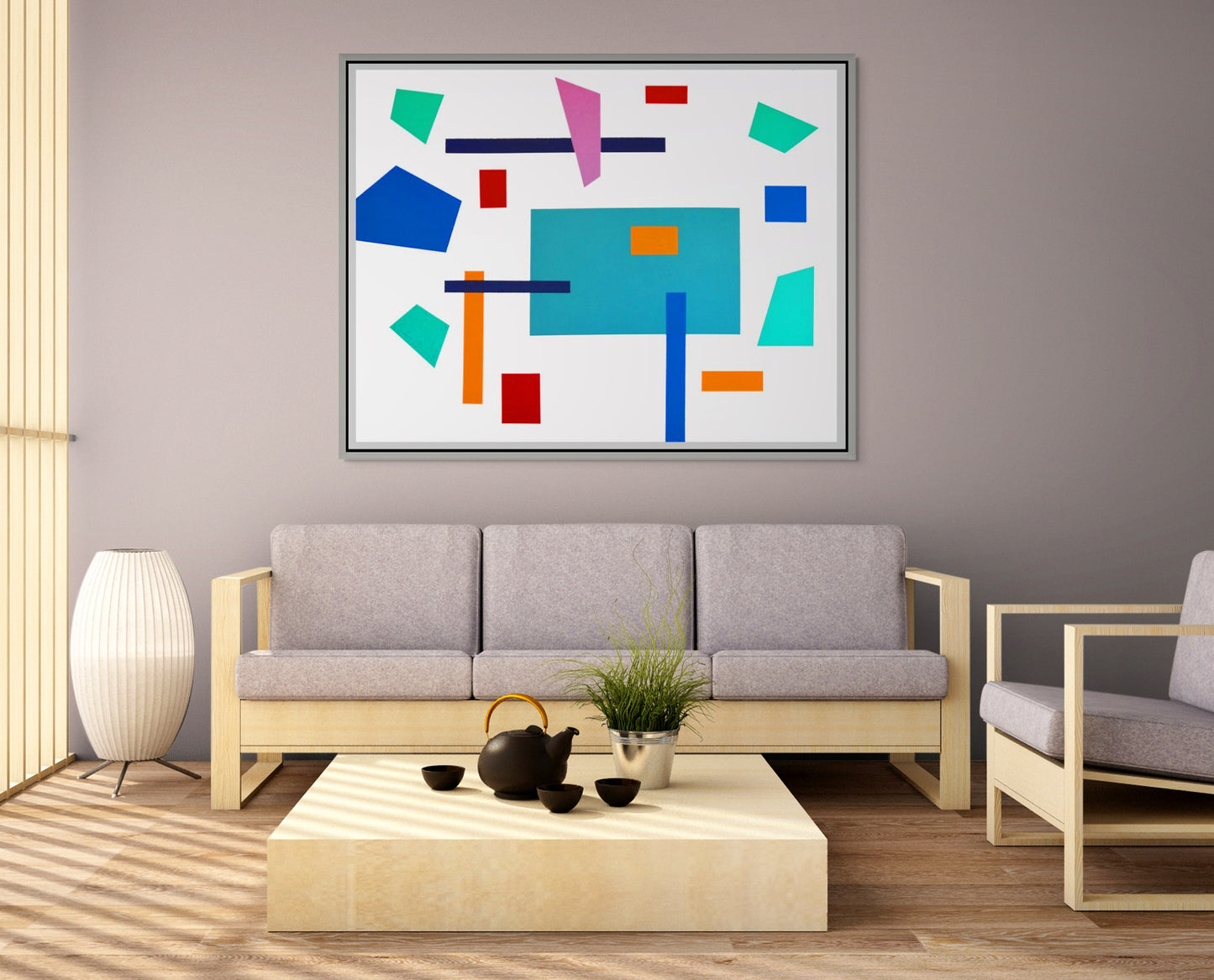Two Black Lines 48" x 60"
Two Black Lines 48" x 60"
See more paintings from the Floating Color Collection.

James Nowak’s Two Black Lines, from his Floating Color Collection, exemplifies the artist’s exploration of geometry, balance, and spatial relationships through abstraction. While the painting shares the vivid chromatic language of its companion works, its compositional focus on two vertical black lines introduces an element of stark contrast, discipline, and structure. This piece sits at the intersection of order and freedom, evoking both constraint and liberation.
At the heart of the composition are the two black vertical lines, which serve as anchors around which other colorful shapes orbit. These lines cut through the canvas with a sharp, unyielding presence, evoking associations with division, separation, or even pillars of stability. They stand in contrast to the surrounding irregular quadrilaterals, rectangles, and trapezoid-like forms that seem to float or drift across the white field.
The large teal rectangle in the center provides mass and weight, while the scattered smaller red, blue, orange, and green shapes destabilize the hierarchy, ensuring that the viewer’s eye is in constant motion. The balance here is not symmetrical but dynamic, creating a sense of visual tension between groundedness and drift.
Nowak’s palette here is bold yet tempered. The dominance of teal and blue establishes a cool tonal base, while the interruptions of orange and red inject warmth and urgency. The pink trapezoid at the lower left destabilizes expectations, acting as a playful counterpoint to the otherwise primary-dominant palette.
The black lines, however, assert themselves as both compositional dividers and visual interruptions. Unlike the buoyant colors, they resist levitation, tethering the floating shapes to an implied grid or order. This interplay between freedom and restraint captures the painting’s essential drama.
As in Sunny Day and other works in the collection, the negative white space is not emptiness but atmosphere. It allows the shapes to hover in suspension, untethered to ground or horizon. The presence of the black lines alters this dynamic: they puncture the atmosphere, creating imagined axes of measurement. The viewer is thus asked to consider how floating and fixed elements coexist in one visual plane.
This oscillation between weightlessness and rigidity reflects on the paradoxes of human perception. While color may express joy, play, or spontaneity, structure (symbolized by the black lines) insists upon order, reminding us of the frameworks within which freedom is experienced.
Emotionally, Two Black Lines is more serious, even meditative, compared to Sunny Day. The black lines evoke solemnity, suggesting boundaries, constraints, or moments of pause. Yet, the surrounding colors soften this austerity, offering optimism and renewal.
Symbolically, one might interpret the two black lines as metaphors for duality: boundaries and possibilities, control and release, stability and change. They are minimal gestures that profoundly alter the painting’s atmosphere, pushing it beyond mere formal play into philosophical territory.
Nowak’s abstraction recalls elements of Constructivism and De Stijl in its devotion to geometric clarity and restrained color interactions. However, his approach diverges in its looseness—the floating, irregular shapes disrupt any strict grid logic. In this sense, Nowak situates himself between the structural exactitude of Mondrian and the playful openness of Matisse’s cut-outs.
By embedding strict verticals within a field of drifting forms, Two Black Lines also converses with Minimalism, where simple gestures become profound meditations on presence, absence, and the conditions of seeing.
Two Black Lines exemplifies James Nowak’s ability to create meaning from the interaction of geometry, color, and space. The painting operates as both a visual delight and a conceptual inquiry, balancing the joy of floating forms with the sobering presence of constraint. In doing so, it reveals the delicate interplay of freedom and structure—an enduring human paradox captured within the stillness of abstraction.

